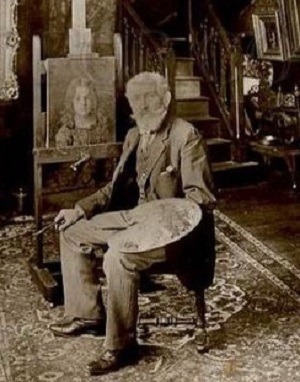

Alexei Harlamoff
RU
103
Artworks
1840 - 1925
Lifespan
Artist Biography
Alexei Alexeievich Harlamoff (1840–1925) was a distinguished Russian painter celebrated for his sensitive portraits, particularly of young girls, and his adherence to the academic tradition, later infused with Parisian influences. Born on October 18, 1840, in the village of Dyachevka near Saratov into a family of serfs, Harlamoff's early life was marked by the social constraints of his era. However, a pivotal moment occurred in 1850 when his family gained their freedom, paving the way for young Alexei to pursue his burgeoning artistic talents. His promise was evident early on, leading him to become a guest student at the prestigious Imperial Academy of Arts in Saint Petersburg in 1854. There, he began to hone his skills, earning his first accolades, including a second-class silver medal for a drawing in 1857, signaling the start of a remarkable artistic journey.
At the Imperial Academy, Harlamoff flourished under the tutelage of historical painter Alexey Tarasovich Markov. He consistently demonstrated excellence, winning a second-class silver medal for a sketch in 1862 and two first-class silver medals in 1863. His academic prowess culminated in significant achievements: a second-class gold medal in 1866 for his painting "Baptizing of the Kiever," and, critically, a first-class gold medal in 1868 for "Return of the Prodigal Son." This latter award was not merely an honor; it granted him a coveted scholarship from the Academy to study in Paris, a city that would profoundly shape his artistic development. He embarked for Paris in 1869, ready to absorb new influences and refine his craft on a larger European stage.
Upon arriving in Paris, Harlamoff quickly immersed himself in the vibrant art scene. His early years abroad included travels to Normandy and the Netherlands with fellow artist Alexey Bogolyubov, and a visit to London to study Old Masters. A significant commission came in 1870 from the Academy of Arts to copy Rembrandt’s "Anatomy Lesson of Dr. Tulp," a task he meticulously executed in The Hague between 1871 and 1872. A crucial turning point was his encounter with Léon Bonnat in 1872, whose independent studio Harlamoff joined. Bonnat's guidance was instrumental, exposing Harlamoff to cosmopolitan artistic currents and refining his portraiture technique. By 1874, Harlamoff was gaining recognition, becoming an Art Academy member for his portrait of the engraver Pozhalostin and integrating into the Russian émigré intellectual circle, which included Ivan Turgenev and the Viardot family, who became important patrons and subjects.
While Harlamoff achieved success with commissioned portraits of eminent figures such as Tsar Alexander II, Ivan Turgenev, and Pauline Viardot-Garcia, he is perhaps most beloved for his genre paintings featuring young girls. Often using his own daughter as a model, these works, sometimes depicting his subjects in Italian or Bohemian attire, are characterized by a gentle innocence and profound sentiment. His artistic style, deeply rooted in Russian academicism, was elegantly leavened by his Parisian experience and Bonnat's influence, resulting in a distinctive blend of meticulous detail, subtle coloration, and a soft, delicate brushwork that lent an intangible quality to his portrayals. This unique sensibility captured the tenderness and fleeting beauty of youth with remarkable empathy.
Throughout his career, Harlamoff actively participated in the art world. He exhibited regularly at the prestigious Paris Salon and was featured in the Universal Exhibitions in Paris (1878, where he won a second-class medal for his portrait of Alexander F. Onegin, and 1900, significantly in the Russian Section). He was a founding member of the Association of Russian Artists for the Mutual Support and Benefaction Abroad in 1877. In 1880, he aligned himself with the progressive Russian art movement by joining the Association of the Itinerant Art Exhibitions (Peredvizhniki), upon Ivan Kramskoi's persuasion. His contributions were recognized with significant honors, including being named a Chevalier of the Legion of Honour in France in 1900 and receiving the Russian Order of St. Vladimir (4th Class) in 1902.
In his later years, Harlamoff continued to paint and exhibit, maintaining his studio in Paris, moving to Boulevard de Rochechouart in 1909. He remained connected to the Russian art scene, participating in exhibitions in Moscow and St. Petersburg. After the death of his mentor Bogolyubov in 1896, Harlamoff became chairman of the Association of Russian Artists in Paris. Alexei Harlamoff passed away in his Paris studio on April 10, 1925, with the soprano Félia Litvinne, a close friend, as his sole heir. Today, his works are held in esteemed museum collections, including the State Russian Museum in St. Petersburg and the Tretyakov Gallery in Moscow, securing his legacy as a masterful Russian painter whose art continues to resonate with its delicate beauty and emotional depth.